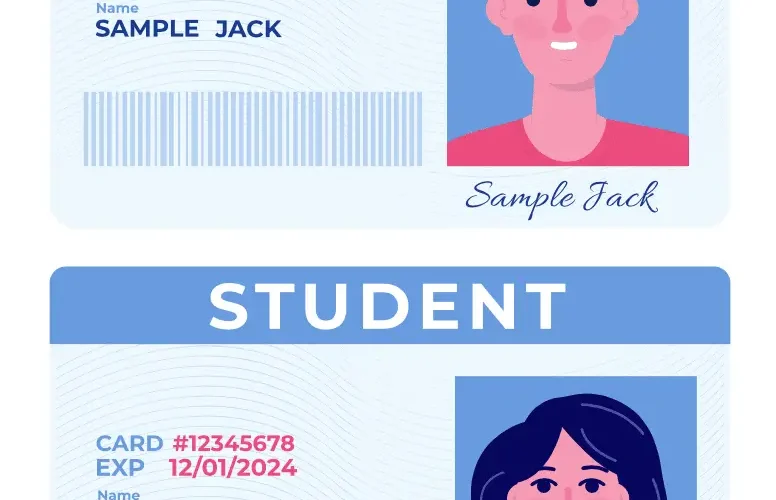A student ID is one of the most “looked-for” things in students’ backpacks. Most of all, it happens to the best of us. See, this little card might seem simple, but it’s actually an important tool for school. It says and shows where you belong. But what exactly is a student ID, a student ID number, and how can one get it?
Well, it might already seem very self-explanatory, but there are more to student IDs than you know. A lot more you can use them for.
In this article, we will discuss the student ID, what it really is, what it is used for, and how to get a student ID number.
Table of contents
What is the student ID number?
A student ID is like a secret code that identifies them at school! This number is called a student ID number. Think of it like a fingerprint, but for school records.
This student ID number is used for many things, like borrowing books from the library or checking in for lunch. It helps teachers and school staff keep track of everyone and ensure their safety.
This number can also be helpful for online school stuff. Sometimes, you might need your child’s student ID number to access their school account or fill out permission slips online. It’s like a little key that unlocks all sorts of school-related things!
So, the next time you see that number on your child’s ID card, you’ll know it’s their special code at school! We’ll answer more questions about student IDs in this post.
Read: What is a Student Profile? What Makes Up a Student Profile
The Broad Scope
While the most evident use might be during examinations or library access, its use runs deeper. It plays a pivotal role in shaping a student’s entire academic experience. From signing up for classes to tracking academic progress, this number is a constant companion.
A student ID number is not just a sequence of digits. It’s a gateway to many services and experiences in an academic setting. As we delve deeper into this topic, you’ll uncover its significance and the modern methods of obtaining it.
Origin of the Student ID
Long before the digital age, identification was essential. The student ID number emerged as schools and universities grew.
They needed a system to manage and identify their growing student population efficiently.
Early Days: Name Tags and Paper Records
In the initial phases, simple name tags or badges were common. However, as institutions expanded, relying solely on names became problematic. Enter the student ID number: a unique sequence of digits assigned to each student.
This system helped organize data and ensure that John Smith from Economics wasn’t confused with John Smith from biology.
The Digital Revolution
As technology evolved, so did the student ID system. By the late 20th century, the student ID number had transitioned from mere paper records to digital formats with the rise of computers and databases.
This streamlined administrative tasks and paved the way for more advanced features. Think of electronic access to dorms, digital library checkouts, and even cashless cafeteria transactions.
To sum up, the journey of the student ID number is a testament to how education systems adapt. From simple name tags to sophisticated digital identifiers, it mirrors the progress of academia in tune with technological advancements.
As we proceed, we’ll discover how this number is even more integral in today’s dynamic educational landscape.
Also, see: What Are The Benefits of Having A Student Bank Account?
The Significance of a Student ID Number
A student ID number might appear as a mere sequence of digits, but its importance is vast. This number serves as a key, unlocking numerous doors in an educational setting.
Navigating Academic Waters
Every student has a unique path. Whether it’s the courses they choose or the grades they earn, the student ID number tracks it all. It ensures that Emily’s chemistry grade doesn’t get mixed up with Jacob’s. In essence, it’s like a student’s academic fingerprint.
Access and Security
Beyond academics, the student ID number is a safety tool. Campuses are vast places, and labs, libraries, and recreation centres often require secure access. With a student ID number, institutions can ensure that only eligible students enter certain areas. It’s like a VIP pass, granting students access to needed resources.
Administrative Ease
Imagine a world without this number. Chaos, right? Registering for classes, applying for dorms, or even getting a meal plan would be a logistical nightmare. The student ID number streamlines these processes, simplifying life for students and staff.
In a nutshell, a student ID number is a powerhouse of functionality. Its significance spans academic, administrative, and security realms, proving that it’s an indispensable part of modern education. As we journey, you’ll learn how this vital tool has evolved with time and technology.
Physical vs. Digital: The Modern Evolution of Student ID
When thinking about a student ID, you might picture a plastic card. However, as we’re in 2023, there’s more to it. Today, we have both physical cards and digital versions. Let’s dive into this evolution.
The Classic Physical ID
Physical student ID cards have a nostalgic charm. They come with a photo, name, and essential student ID number. Beyond identification, they often serve other roles. Swipe them at the library, use them in the cafeteria, or flash them for event access. They’re tangible, straightforward, and have been a staple for decades.
Digital IDs: The New Kids on the Block
Enter the age of smartphones and apps. Now, many institutions offer digital student IDs. These live on your phone, providing the same features without the plastic. Lost your card? No problem. You’re always covered with digital IDs as long as you have your device. Plus, they can offer quick updates and are often more eco-friendly.
Which Reigns Supreme?
It’s not about one being better than the other. Each has its merits. Physical IDs provide familiarity, while digital ones boast convenience. Institutions often give students a choice or use a hybrid model.
Student IDs have adapted to fit the needs of today’s learners, whether you prefer plastic or a swipe on a screen.. The evolution reflects the blend of tradition and innovation in education.
Also, read: What is a Student Certificate? How Do Acquire One Easily?
How to find my student ID number
Here’s how to get your student ID number:
- Embarking on the ID Journey: Getting your student ID number might seem challenging, but with a step-by-step guide, it’s a breeze. Here’s how to navigate this process smoothly.
- Initial Registration: It all begins with registering at your institution. Once enrolled, you’re on the radar, whether online or in person. The institution then processes your details.
- Automatic or Manual Assignment: Most schools now use automated systems. They generate a unique student ID number for you. Some places might still have a manual method, where an admin assigns it. Either way, you’ll get a distinct number.
- Retrieving Your Number: In most cases, after your enrollment is complete, you’ll receive an official email or postal notification. This message will have your student ID number. Ensure you store it safely!
- Physical ID Card Collection: If your institution offers physical ID cards, there’s often a designated place to pick them up. Sometimes, it’s the admin office; other times, it’s a specific ID centre. Remember to bring any required documents or proof of enrollment.
- Setting Up a Digital ID: You might need to download an app or access a portal for digital IDs. Follow the instructions, input your details, and voila! Your digital student ID is ready.
Safety and Privacy Concerns
Here are the safety and privacy concerns for student ID in the modern age:
Navigating the Digital Age Safely
The power of a student ID number is immense. But with great power comes the need for great responsibility. Safety and privacy surrounding this number are vital in our digital age. Let’s explore how to stay secure.
The Risks
While the student ID number simplifies many tasks, it’s also a target. Cyberattacks, identity theft, or simple misuse can lead to problems. For instance, someone might access your academic records or misuse campus facilities in your name.
Data Protection Measures
Schools and universities take this seriously. They often employ robust encryption methods and firewalls, which means they use digital walls and codes to keep your data safe. Always ensure your institution adheres to the latest security protocols.
Staying Safe: Tips for Students
- Guard Your ID: Treat your student ID number like a precious secret. Don’t share it carelessly.
- Update Passwords: Change passwords regularly if your number is linked to online portals. Avoid easy ones like “password123.”
- Report Losses: Have you lost your physical card? Report it ASAP so the institution can deactivate it and prevent misuse.
Digital Safety Net
Many schools now offer two-factor authentication (2FA). This means even if someone knows your password, they need a second verification (like a code sent to your phone) to access your account.
In summary, while the digital world offers convenience, it demands caution. By understanding risks and taking proactive steps, your student ID number remains a tool, not a vulnerability.
Also, see: How Many Years of Student Finance Can You Get in the UK?
How often should you renew or update your Student ID?
The student ID number remains constant for many students, but the physical or digital ID card bearing that number might have an expiration date. Here’s a breakdown:
Set Duration by Institutions
Most educational institutions determine the longevity of student ID cards. Some provide IDs to last throughout your tenure, while others might set a yearly expiration.
Signs to Renew
If your card is present, always check its expiry date. Renewal often coincides with yearly registration or the start of a new academic year.
Why Renew?
Renewals help keep student data updated. A new photo, change in major, or any other significant detail alteration often mandates a new card. Plus, fresh cards can ensure continued access to campus facilities and maintain security standards.
While it might remain unchanged, the card or digital ID associated with it can require periodic updates. It’s always best to consult your institution’s administrative office for specific guidelines.
Frequently Asked Questions
If you misplace your ID, immediately report it to the admin office. They’ll guide you through deactivation and reissuing procedures, ensuring your student ID number remains protected.
While primarily for academic tasks, your ID can often be more versatile. Many local businesses offer student discounts and use your ID for verification. However, always be cautious about where and when you share your student ID number.
Typically, institutions set the validity. Some IDs last throughout your academic journey, while others need yearly updates. Always check the expiry date, if any, and renew accordingly.
Yes! It is crucial whether you study in person or online. It aids in accessing digital resources, tracking progress, and more.
Conclusion
From its inception to its present-day digital avatar, the student ID number remains a cornerstone of academic life. As we transition into the digital age, we can anticipate even more innovative identification methods.
Imagine biometric integrations or even AI-powered systems that personalize the student experience. One thing’s certain: the student ID number’s role will only grow, adapting and evolving with the ever-changing educational landscape. Stay informed, stay updated, and embrace the exciting transformations ahead.
References
- getsmartsoon.com – What Is a Student ID Number?: How They Are Assigned and Used
- thinkstudent.co.uk – How Do You Find Your Student ID Number?





